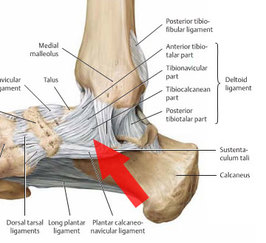Ankle Sprains
There are so many different types of ankle sprain. So many different structures that can be affected and so many degrees of injury. Ever heard the commentators talking about players being out for 12 weeks with a high ankle sprain? Others are back in a few short weeks following a “simple” ankle sprain.
Here are some pictures of your ankle anatomy.


It is easy to see the lateral ligaments (on the outside of the ankle) are small (and multiple). The inside ligaments are thick and substantial.
Common ankle sprain
High ankle sprains
Less commonly but more seriously are the syndesmosis injuries. These are known as high ankle sprains. This ligament (s) holds your two shin bones (tibia and fibula) together above your ankle. Injury to these ligaments occurs as you suddenly twist while your foot is planted on the ground.
A high ankle sprain results in pain above your ankle joint centrally. Often a weight-bearing x-ray is required to assess the degree of injury (and if more invasive treatment is required). Treatment of these injuries can require a boot for up to 6 weeks, return to sport doesn’t often occur before 3 months.
How your physio can help
It is your physio’s role to adequately assess your injury to help diagnose the extent of damage. Listen to their advice, as disappointing as it can be when it means missing sport/exercise. Ligament damage is difficult to heal well, do it right the first time to prevent re-occurrence.
#physiocronulla #anklesprain #loveyourlife
